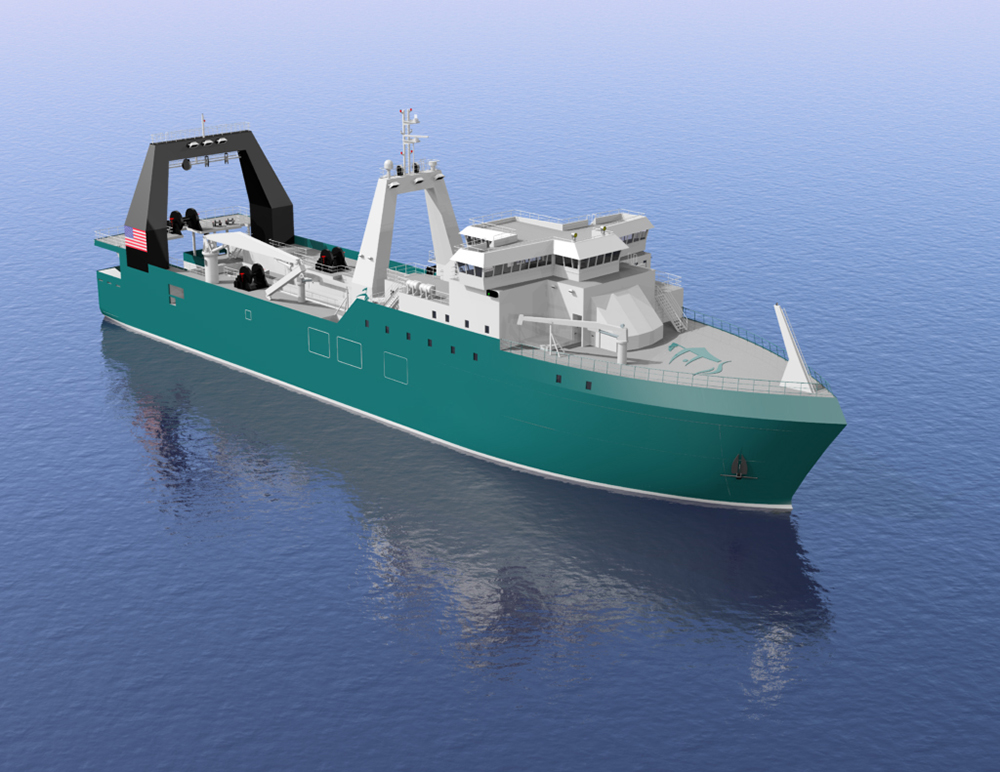
As I walked among exhibitors at the Pacific Marine Expo in Seattle last winter, a 319-foot design rendering of a factory trawler at the Elliott Bay Design Group (EBDG) display caught my eye.
Advertised as the ideal addition to the pollock fleet in the Gulf of Alaska and Bering Sea, the vessel concept was specifically meant to maximize ease of construction and affordability for U.S. shipyards. I later caught up with Jim Towers, EBDG‘s chief concept engineer, who designed the build, to get the inside scoop. Towers has been in the naval-architect-and-design industry for nearly 50 years and has worked with EBDG for around 16 years.
According to Towers, the 319-foot factory-trawler design was put together some years back for a potential client.
“It was basically an AFA (American Fisheries Act) boat,” he said.
“They (the client) participated in the preparation of the design, but they elected not to move forward with it at the time,” Towers explained. “The potential client decided not to build back in 2017-2018 and we haven’t seen any real interest from other owners at this juncture.”
Towers cited macrolevel trends that act as headwinds to new American boat projects like his 319-footer.
“The overall market conditions for shipbuilding haven’t been favorable,” he explained. “There have been big increases in labor costs in the United States.”
Other factors like increases in steel prices and supply-chain uncertainties during and post-pandemic have pushed industry players to extend the lives of their existing vessels rather than look to new construction.
“The only new AFA trawler on the horizon,” he said, “is the Arctic Fjord, which is getting pretty close to completion.”
America-Focused & Northward Ready
The design may be on the shelf for now, but it still stands as a viable project. The 319-footer can accommodate 127 people and was intended to generate around 120 tons a day of production. The boat holds enough space for both a fillet and surimi factory. A 7,500-kW main engine with a shaft generator is a main feature, which is estimated to provide a 13.5-knot cruising speed and 15-knot maximum speed.
“She was designed with a fish-meal plant in her and more automated cargo handling,” Towers said.
A cargo elevator for loading and unloading the freezer hold and pallet storage are features to this end. Six automated-plate freezers and four manual-plate freezers with automated palletizing and buffer storage are a part of the system. The hull form is best described as familiar.
“Pretty traditional trawler design, she’s got a bulbous bow and box keel,” Towers remarked. “She was designed with a propeller obviously, and a very easy runner and she was a good towing boat.”
Affordability to an American client was a foremost consideration.
“This one was designed with the aim of keeping construction as cheap as possible, she stayed away from an awful amount of curves and fancy wheelhouses you see in designs,” Towers explained. “This was built to be as cheap to build as it could possibly be while still having a good hull form underwater.”
Keeping construction simple helps reduce labor costs for a potential American builder.
Trends & Possibilities
For Towers, a major consideration for the American commercial fishing market is toughness. American companies and operators tend to keep their vessels in operation for longer than other markets, preferring to refit and repower versus retire and purchase anew.
“You’re trying to build a boat that’s pretty robust,” he explained. “The European boats tend to be designed for a 15- or 20-year lifespan, whereas in the states we see people coming back to do mid-life refits and repowers of the boats.”
Most of the AFA fleet dates from the 1990s and 1980s.
“You know, they are still in service and most of them are going to remain in service for a while yet,” Towers said.
Improvements to existing boats also eliminate boats from the fleet as operators can catch their fishing quotas with fewer, modernized vessels. At the end of the day, it’s all about turning a profit. For the 319-footer, construction just isn’t in the cards for now.
“If you can’t make a profit, it’s not worth doing,” Towers remarked, adding that while the design is on hold, it is ready to go if given the chance.
“It’s on the shelf and if it were to come back to life, we’ve seen developments particularly in the European boats over the last eight years so,” he said. “We’d probably update it quite significantly if it were to come back to life and get going.”
EBDG has been leading the charge in the areas of new fuel sources, notably their methanol-powered, hydrogen fuel cell tugboat m/v Hydrogen One, one of Towers’ latest projects.
“(The m/v Hydrogen One is) one of the most challenging vessels I’ve had to work on, it’s quite interesting,” Towers commented.
If resurrected and modernized, would the 319-footer feature a new energy system?
“Alternate energy is] probably a little out there, and I’m not aware of anyone yet in the fishing fleet working with an alternative fuel,” Towers said.
Factory trawlers generally need every cubic foot of space that’s available, and most of the alternate fuels require more storage space and are heavier and a lot more expensive.
“As these technologies mature, I expect to see methanol or ammonia used in the fishing fleet,” he said. “But that’s probably still a few years away yet.”
Towers added that he would relish the opportunity to work on such a challenge.
“We’d love to do the first alternative fuel trawler in the U.S.,” he said.
For now, the 319-foot made-for-America trawler from EBDG is a “maybe someday.” But who can say for certain what tomorrow will bring?
Norris Comer is a Seattle-based writer and author. His debut memoir, Salmon in the Seine: Alaskan Memories of Life, Death, & Everything In-Between is now available wherever books are sold. You can find him on Substack, Instagram and at norriscomer.com. He can be reached via email at norriscomer@substack.com.
